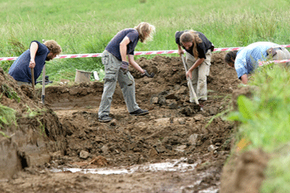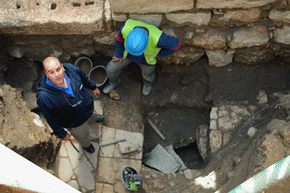In the classic adventure movie "Raiders of the Lost Ark," the bulk of the action comes when professor/adventurer/archaeologist Indiana Jones battles grave-robbing Nazis for the lost Ark of the Covenant. In the film, director Steven Spielberg draws a distinct line between the intent of the movie's hero and the intent of his money-hungry foil, Dr. Rene Belloq. Belloq is depicted as the anti-Indiana Jones, an archaeologist who has lost his way and given in to the temptations of becoming a treasure hunter for hire. Take a close look at the film's title, though. It's not called "The Legitimate Archaeologist and the Grave Robber." According to the title, they're all "raiders" of the lost ark -- Dr. Jones included. This begs the question: Where is the line drawn between archaeology and grave robbing?
It's a tough question to answer because there's no single law that states when an artifact becomes historically significant. In the world of antiques, the general rule is that an item between 75 and 100 years old is a valued collectible. United States customs laws put the number squarely at 100 years old. So does this mean that anything more than 100 years old is fair game for research? Not necessarily. Just try digging up a 105-year-old grave and taking the pocket watch from the coffin. This is called grave robbing, and it's illegal. But what if the site was a Native American burial plot and a university researcher applied for and received a permit to excavate the site? Then it's archaeology, which is protected by law, as long as the dig is conducted according to the state's guidelines. A permit makes a big difference in the differentiation between archaeology and grave robbing. It's the basis for what makes an excavation legitimate. Each state in the United States has a governing body, usually headed by the state archeologist, which spells out the guidelines for a legal excavation.
Advertisement
The distinction that most archaeologists point out is the intent behind an excavation. An archaeologist's job is to piece together human history and prehistory. This is largely accomplished by excavating sites, which are often tombs and burial grounds because humans have a long history of burying items important to the deceased with the body. So, if you find the remains of a 400-year-old corpse, there's a good chance there are other items with the bones of the dead. These objects can tell an archaeologist a lot about the era. If a body from the ice age is found frozen in time with a spear in his rib cage and a crude hammer in his hand, it tells us a great deal about how advanced he was, how he hunted and how he survived.
Grave robbers, on the other hand, typically have one purpose in mind -- to sell off artifacts for profit to unscrupulous collectors, or on the thriving antiquities black market. Grave robbers and looters have no interest in the historical significance of the object, just what it can fetch on the open or underground market. It appears the easy answer, then, is: Grave robbers are working strictly for profit, while archaeologists are interested solely in research.
Not so fast. In recent years, there's been big debate about booty found on shipwrecks and what makes it different than items found through land-based excavation.
Advertisement

